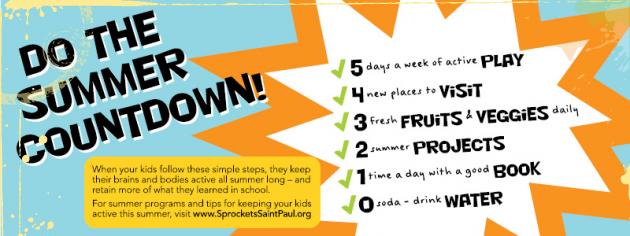Imagining, planning and creating an open-ended project gives kids a chance to flex their creative muscle and develop a sense of pride in their accomplishments. “2 Summer Projects” can build upon young people’s areas of interest or help them develop new passions.
Get Involved In Your Community.
Older children and teens might enjoy volunteering at an animal shelter or being part of the creative fun at Public Art Saint Paul. Youth can start a neighborhood recycling program or clean-up or even organize a clothing drive or other community service project.
Get Creative.
Young people of all ages enjoy writing songs and poetry, or creating a journal, scrapbook or an original story. Youth with a passion for video can also check out St. Paul Neighborhood Network (SPNN) and be part of a real television production.
Write and put on a play, musical or rap performance for friends and family, or even YouTube. Build a tree house or fort with scrap materials (with adult supervision for young ones). Be inspired by "Caine's Arcade" the story of a nine-year old California boy who spent his summer vacation building an elaborate cardboard arcade in his dad’s used auto parts store. Could you make something this cool in your basement or garage?
Get Crafty.
There’s always arts and craft projects to keep little hands and bright minds busy! Check out Art Scraps or Ax Man for a seemingly endless array of recycled materials, doo-dads and gizmos to spark creativity.
Visit your local library and check out different craft books or browse the Family Fun magazine for a wide array of art projects, recipes that kids can make, as well as backyard games for every season and celebration.
Get Going!
We love the Great Schools website. It’s jam-packed with creative summer projects and ideas – as well as suggested books and parenting videos -- sorted by age and grade. Here are just a few of our favorite projects from their site:
- Create a “Summer Fun Bag”: Save clippings (or create your own little notes or drawings) with activities, crafts, and simple things to do, like a picnic, sidewalk chalk, bubbles, etc. Let your child draw one idea out of the bag every day and then do the project that was selected.
- Create a scavenger hunt in the city park: Together with your kids, make a list (or bingo card!) of things to find at the park. Ideas can be simple like a dandelion, something blue, something red, a large rock, etc. Each child searches the park for the things on the list, and then show or tell each other what you’ve found.
- Grow plants hydroponically: Young people can learn to grow plans hydroponically (in water, without soil) using recycled water bottles. Using their own vegetables and herbs, they can then help plan or prepare a family meal, or make a healthy donation to a local food shelf. (All while learning the science behind this environmentally-friendly, high-yield growing practice)!

